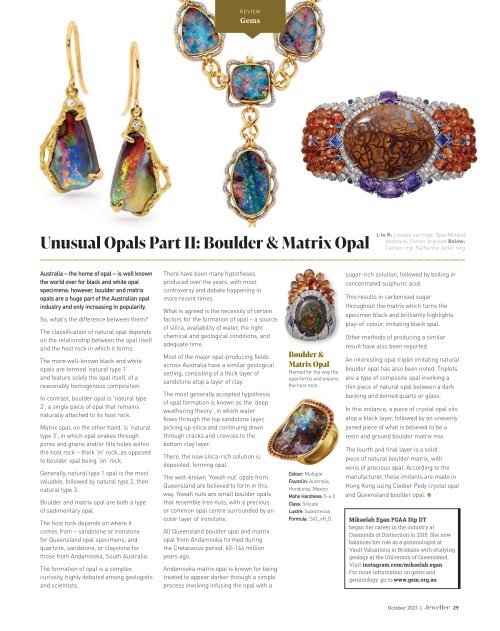Jeweller - October 2021
• Home advantage: Australian and New Zealand brands prove their worth • Lab-grown up: innovations and market developments in the lab-created diamond category • Christmas ready: prepare for the holiday season with exciting new products
• Home advantage: Australian and New Zealand brands prove their worth
• Lab-grown up: innovations and market developments in the lab-created diamond category
• Christmas ready: prepare for the holiday season with exciting new products
Create successful ePaper yourself
Turn your PDF publications into a flip-book with our unique Google optimized e-Paper software.
REVIEW<br />
Gems<br />
Unusual Opals Part II: Boulder & Matrix Opal<br />
L to R: Linneys earrings; Opal Minded<br />
necklace; Cartier bracelet Below:<br />
Cartier ring; Katherine Jetter ring<br />
Australia – the home of opal – is well known<br />
the world over for black and white opal<br />
specimens; however, boulder and matrix<br />
opals are a huge part of the Australian opal<br />
industry and only increasing in popularity.<br />
So, what’s the difference between them?<br />
The classification of natural opal depends<br />
on the relationship between the opal itself<br />
and the host rock in which it forms.<br />
The more well-known black and white<br />
opals are termed ‘natural type 1’<br />
and feature solely the opal itself, of a<br />
reasonably homogenous composition.<br />
In contrast, boulder opal is ‘natural type<br />
2’, a single piece of opal that remains<br />
naturally attached to its host rock.<br />
Matrix opal, on the other hand, is ‘natural<br />
type 3’, in which opal snakes through<br />
pores and grains and/or fills holes within<br />
the host rock – think 'in' rock, as opposed<br />
to boulder opal being 'on' rock.<br />
Generally, natural type 1 opal is the most<br />
valuable, followed by natural type 2, then<br />
natural type 3.<br />
Boulder and matrix opal are both a type<br />
of sedimentary opal.<br />
The host rock depends on where it<br />
comes from – sandstone or ironstone<br />
for Queensland opal specimens, and<br />
quartzite, sandstone, or claystone for<br />
those from Andamooka, South Australia.<br />
The formation of opal is a complex<br />
curiosity, highly debated among geologists<br />
and scientists.<br />
There have been many hypotheses<br />
produced over the years, with most<br />
controversy and debate happening in<br />
more recent times.<br />
What is agreed is the necessity of certain<br />
factors for the formation of opal – a source<br />
of silica, availability of water, the right<br />
chemical and geological conditions, and<br />
adequate time.<br />
Most of the major opal-producing fields<br />
across Australia have a similar geological<br />
setting, consisting of a thick layer of<br />
sandstone atop a layer of clay.<br />
The most generally accepted hypothesis<br />
of opal formation is known as the ‘deep<br />
weathering theory’, in which water<br />
flows through the top sandstone layer,<br />
picking up silica and continuing down<br />
through cracks and crevices to the<br />
bottom clay layer.<br />
There, the now silica-rich solution is<br />
deposited, forming opal.<br />
The well-known ‘Yowah nut’ opals from<br />
Queensland are believed to form in this<br />
way. Yowah nuts are small boulder opals<br />
that resemble tree nuts, with a precious<br />
or common opal centre surrounded by an<br />
outer layer of ironstone.<br />
All Queensland boulder opal and matrix<br />
opal from Andamooka formed during<br />
the Cretaceous period, 60–144 million<br />
years ago.<br />
Andamooka matrix opal is known for being<br />
treated to appear darker through a simple<br />
process involving infusing the opal with a<br />
Boulder &<br />
Matrix Opal<br />
Named for the way the<br />
opal forms and enjoins<br />
the host rock<br />
Colour: Multiple<br />
Found in: Australia,<br />
Honduras, Mexico<br />
Mohs Hardness: 5–6.5<br />
Class: Silicate<br />
Lustre: Subvitreous<br />
Formula: SiO 2<br />
.nH 2<br />
O<br />
sugar-rich solution, followed by boiling in<br />
concentrated sulphuric acid.<br />
This results in carbonised sugar<br />
throughout the matrix which turns the<br />
specimen black and brilliantly highlights<br />
play-of-colour, imitating black opal.<br />
Other methods of producing a similar<br />
result have also been reported.<br />
An interesting opal triplet imitating natural<br />
boulder opal has also been noted. Triplets<br />
are a type of composite opal involving a<br />
thin piece of natural opal between a dark<br />
backing and domed quartz or glass.<br />
In this instance, a piece of crystal opal sits<br />
atop a black layer, followed by an unevenly<br />
joined piece of what is believed to be a<br />
resin and ground boulder matrix mix.<br />
The fourth and final layer is a solid<br />
piece of natural boulder matrix, with<br />
veins of precious opal. According to the<br />
manufacturer, these imitants are made in<br />
Hong Kong using Coober Pedy crystal opal<br />
and Queensland boulder opal.<br />
Mikaelah Egan FGAA Dip DT<br />
began her career in the industry at<br />
Diamonds of Distinction in 2015. She now<br />
balances her role as a gemmologist at<br />
Vault Valuations in Brisbane with studying<br />
geology at the University of Queensland.<br />
Visit instagram.com/mikaelah.egan<br />
For more information on gems and<br />
gemmology ,go to www.gem.org.au<br />
<strong>October</strong> <strong>2021</strong> | 29


















